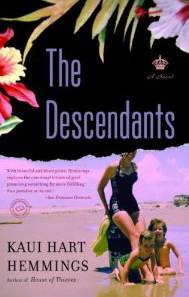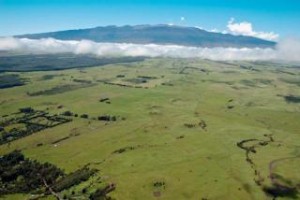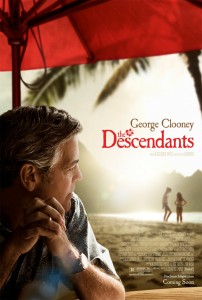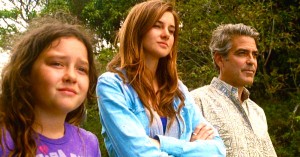“I think of our bloodline’s progression. Our missionary ancestors came to the islands and told the Hawaiians to put on some clothes, work hard, and stop hula dancing. They make some business deals on the way, buying an island for ten grand, or marrying a princess and inheriting her land, and now their descendants don’t work. They have stripped down to running shorts or bikinis and play beach volleyball and take up hula dancing.”
 Matt King, who is a descendant of a Hawaiian princess and the haole who married her and inherited her land, could “sit back and watch as the past unfurls millions into [his] lap,” but he prefers to live on his own salary as a lawyer. The primary beneficiary of the family land trust, Matt is now trying to decide what to do with the land on behalf of his cousins and family since the trust is in debt and the demand for prime land in Hawaii is enormous. Though the land has been in the family since the 1840s, developers have been solicited for bids, and some of the twenty-one beneficiaries of the trust are anxious to reap the millions which will come to them with a sale.
Matt King, who is a descendant of a Hawaiian princess and the haole who married her and inherited her land, could “sit back and watch as the past unfurls millions into [his] lap,” but he prefers to live on his own salary as a lawyer. The primary beneficiary of the family land trust, Matt is now trying to decide what to do with the land on behalf of his cousins and family since the trust is in debt and the demand for prime land in Hawaii is enormous. Though the land has been in the family since the 1840s, developers have been solicited for bids, and some of the twenty-one beneficiaries of the trust are anxious to reap the millions which will come to them with a sale.
As we discover from the beginning, however, Matt will be making no decisions in the immediate future. His thrill-seeking wife Joanie, who had been pushing for the sale of the land to a particular developer, now lies comatose after a boating accident, and her lack of progress alarms the doctors at Queens Hospital in Honolulu, who have her on life support. Their two daughters, one a seventeen-year-old model, and the other a precocious  ten-year-old attention-seeker who torments other girls, have not had the kind of close care and attention they need, except from the housekeeper, and Matt has now committed himself to learning for himself who these daughters really are and what they are doing with their lives—until Joanie gets better, he thinks. He intends to become the guiding force in their lives—a bit late for this effort, perhaps, but he is well-intentioned, nevertheless.
ten-year-old attention-seeker who torments other girls, have not had the kind of close care and attention they need, except from the housekeeper, and Matt has now committed himself to learning for himself who these daughters really are and what they are doing with their lives—until Joanie gets better, he thinks. He intends to become the guiding force in their lives—a bit late for this effort, perhaps, but he is well-intentioned, nevertheless.
When Joanie takes a turn for the worse, older daughter Alexandra returns home to Oahu from boarding school on the Big Island and, accompanied by Sid, a friend from a previous school, determined she will live her own life, even under the eyes of her father at home. Scottie, the ten-year-old, continues to act out. As Matt visits their close friends and Joanie’s family to tell them about Joanie’s condition, his internal dialogue and self-examination really begin, and as Joanie lingers in the hospital, Matt’s discoveries about her and their relationship lead to important lessons and new awareness of his own responsibilities.
The clear, often  humorous presentation of events, the exceptionally realistic dialogue, and unique imagery give life to this strong debut novel, and the narrative speeds along as each character tries to deal with Joanie’s declining condition. The author’s insights into Matt’s conflicts and his self-examination during his long vigil, along with his daughters’ understandable tumult, provide some emotional resonance, even as moments of dark humor provide some respite from the tension. The subplots, involving the decision on whether to take Joanie off life support, the issues involving sale of the land, the individual problems of the daughters, the background of Alexandra’s friend Sid, and the sudden discovery of Joanie’s lover and whether to involve him in her hospitalization, are well integrated, and the conclusion is satisfying.
humorous presentation of events, the exceptionally realistic dialogue, and unique imagery give life to this strong debut novel, and the narrative speeds along as each character tries to deal with Joanie’s declining condition. The author’s insights into Matt’s conflicts and his self-examination during his long vigil, along with his daughters’ understandable tumult, provide some emotional resonance, even as moments of dark humor provide some respite from the tension. The subplots, involving the decision on whether to take Joanie off life support, the issues involving sale of the land, the individual problems of the daughters, the background of Alexandra’s friend Sid, and the sudden discovery of Joanie’s lover and whether to involve him in her hospitalization, are well integrated, and the conclusion is satisfying.

The character of Matt is not based on any particular person, but Hawaiian readers cannot help but make associations between him and the Big Island’s Parker family, adding an aura of “realism” to Matt’s exotic background as the heir of a princess. (The Parker family of the Big Island, descended from a Hawaiian princess and amassed a 240,000-acre ranch, the largest privately owned ranch in the country, before estate taxes led to the sale of some land in the past generation.) His generosity toward Joanie’s lover strains credulity, however, and the peripheral characters often exhibit extreme behavior with which it is difficult to sympathize. A number of unusually dramatic and cinematic moments late in the novel make this a good melodrama, and prime fodder for an exciting film, though not necessarily an emotionally resonant one. Entertaining, and filled with tugs at the heartstrings, The Descendants captures the life of a family at a crossroads, and does so with lively self-assurance.
Notes: The newly rel eased film of this novel, starring George Clooney as Matt King, has received rave reviews in Hawaii and elsewhere. In the film the family’s land trust is located on Kauai, rather than the Big Island, but the other major aspects of the novel apparently remain unchanged, and the acting of the cast seems to elevate this story above the melodrama that overwhelmed this book for me. (Will review the film when I see it.) See NYTimes review: http://movies.nytimes.com
eased film of this novel, starring George Clooney as Matt King, has received rave reviews in Hawaii and elsewhere. In the film the family’s land trust is located on Kauai, rather than the Big Island, but the other major aspects of the novel apparently remain unchanged, and the acting of the cast seems to elevate this story above the melodrama that overwhelmed this book for me. (Will review the film when I see it.) See NYTimes review: http://movies.nytimes.com
The author’s photo is from http://www.wordandfilm.com
The unlimited horizons of the Parker Ranch land are seen in this photo, which also shows Mauna Kea, home of the Keck Observatory: http://www.localpropertyindex.com
The cover of the paperback, released to coincide with the film shows George Clooney as Matt King.
In the film, Matt King and his two daughters face the trauma of the accident of their wife/mother. http://movies.nytimes.com The review of the film may be seen by clicking on this link.
The film trailer is here:
